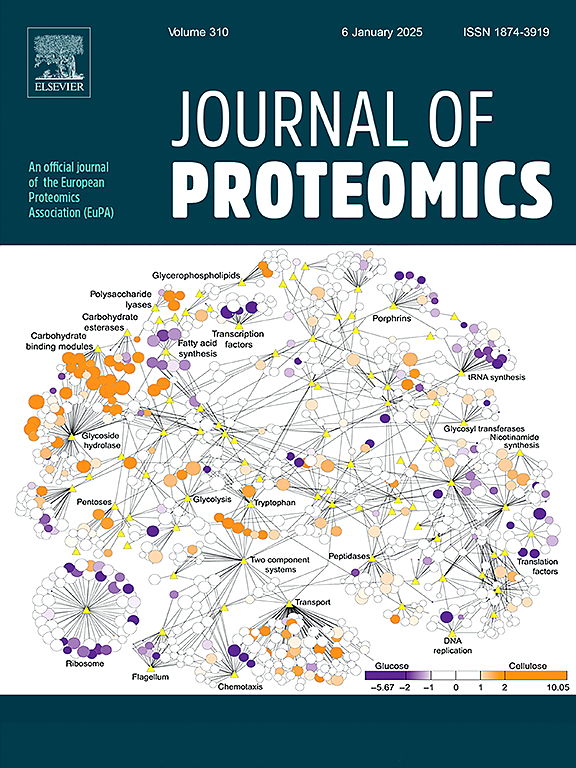Differentiating goose eggshells through proteomics: A case study from Xitou, North China
IF 2.8
2区 生物学
Q2 BIOCHEMICAL RESEARCH METHODS
引用次数: 0
Abstract
Eggshells are significant cultural symbols linked to funeral customs and social development. Identifying their species is crucial in archaeological research. However, their small fragment size makes eggshells difficult to accurately identify using traditional methods. Recent mass spectrometry advances have significantly enhanced eggshell species identification in archaeological research, but their success remains limited. For example, Anser cygnoides and Anser anser eggshells cannot yet be reliably distinguished. This paleoproteomic study uses Zooarchaeology by Mass Spectrometry and Liquid Chromatography-Tandem Mass Spectrometry to identify by proteotyping the species of eggshells from the Xitou site in China. We established a series of peptide markers and amino acid variants to distinguish A. cygnoides from A. anser, and with this method attribute three Xitou eggshell specimens to the graylag goose. Carbon isotope analysis and shell thickness measurements were conducted to understand the domestication of the geese associated with these eggshells. The isotope results indicate that these geese primarily ate C3 plants, and shell thickness results suggest they were possibly domesticated. These findings firstly provide direct molecular evidence of possibly domesticated graylag geese in China and offer new insights into poultry domestication and cultural practices.
Significance
Combing ZooMS and LC-MS/MS analysis, we have identified novel peptide markers to distinguish the eggshells of swan goose (Anser cygnoides) from those of graylag goose (Anser anser). Using a series of ZooMS markers and amino acid variations, the eggshells from Xitou site (north China) were identified to be derived from graylag goose. Further eggshells thickness and isotope analysis show that these geese were likely domesticated and primarily fed on C3 plants, offering valuable insights into early geese farming and sustainable practices during the Western Zhou period. Furthermore, the discovery of eggs as burial items highlights the important role that geese played in ancient Chinese culture and rituals.

用蛋白质组学方法鉴别鹅壳:以西头鹅壳为例
蛋壳是与丧葬习俗和社会发展相关的重要文化符号。鉴定它们的种类在考古研究中是至关重要的。然而,它们的小碎片尺寸使得使用传统方法难以准确识别蛋壳。近年来质谱技术的进步极大地提高了蛋壳物种鉴定在考古研究中的应用,但它们的成功仍然有限。例如,天鹅座应答器和蛋壳应答器还不能可靠地区分。本研究采用动物考古学、质谱联用、液相色谱-串联质谱联用技术对中国西头遗址的蛋壳进行了蛋白质组学鉴定。我们建立了一系列肽标记和氨基酸变异来区分鹅和鹅,并以此方法将3个西头鹅蛋壳标本归为灰雁。通过碳同位素分析和蛋壳厚度测量来了解与这些蛋壳相关的鹅的驯化情况。同位素结果表明,这些鹅主要吃C3植物,壳厚结果表明它们可能是驯化的。这些发现首次为中国可能驯化的灰雁提供了直接的分子证据,并为家禽驯化和文化实践提供了新的见解。意义利用ZooMS和LC-MS/MS分析,我们发现了新的肽标记,可以区分天鹅(Anser cygnoides)和灰雁(Anser Anser)蛋壳。利用一系列ZooMS标记和氨基酸变异,鉴定了中国北方西头遗址的蛋壳来自灰雁。进一步的蛋壳厚度和同位素分析表明,这些鹅可能是驯化的,主要以C3植物为食,这为西周时期早期的鹅养殖和可持续实践提供了有价值的见解。此外,作为陪葬品的蛋的发现凸显了鹅在中国古代文化和仪式中的重要作用。
本文章由计算机程序翻译,如有差异,请以英文原文为准。
求助全文
约1分钟内获得全文
求助全文
来源期刊

Journal of proteomics
生物-生化研究方法
CiteScore
7.10
自引率
3.00%
发文量
227
审稿时长
73 days
期刊介绍:
Journal of Proteomics is aimed at protein scientists and analytical chemists in the field of proteomics, biomarker discovery, protein analytics, plant proteomics, microbial and animal proteomics, human studies, tissue imaging by mass spectrometry, non-conventional and non-model organism proteomics, and protein bioinformatics. The journal welcomes papers in new and upcoming areas such as metabolomics, genomics, systems biology, toxicogenomics, pharmacoproteomics.
Journal of Proteomics unifies both fundamental scientists and clinicians, and includes translational research. Suggestions for reviews, webinars and thematic issues are welcome.
 求助内容:
求助内容: 应助结果提醒方式:
应助结果提醒方式:


